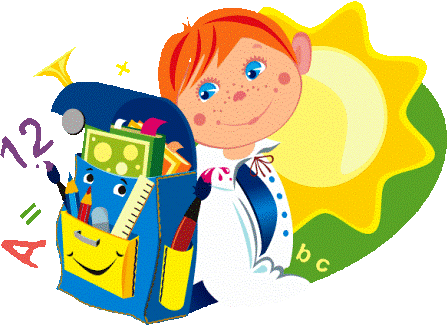Chairman: Good afternoon, dear colleagues and our guests – the
correspondents of
different newspapers! We start our press conference. It is devoted to
the latest
discoveries of our laboratory X. You can see the greatest scientists
here. Let me
introduce them: Mr Petrov, Mr Ivanov, Mr Alexandrov, Mrs Pospelova, Mrs
Guralevich. They
are ready to answer your questions.
Mr Brown: I’d like to ask you a question. "Daily
Telegraph” newspaper. I
heard that your laboratory invented a device for measuring temperature
of water. What have
you to tell us?
Chairman: Mr Petrov has the floor.
Mr Petrov: The problem was to find whether any liquid is
cold or hot. The following
experiment shows how easy it is to be mistaken. We have three glasses
(glass 1 contains
cold water, glass 2 – very hot water, glass 3 – water at room
temperature). Will you
help me, please, Mr Brown? Could you come here, please? Will you put a
finger of your
right hand into glass1, and a finger of your left hand into glass2? Half
a minute later
put the finger from glass1 into glass 3. Is it cold?
Mr Brown: No, it’s warm.
Mr Petrov: And now put the finger from glass 2 into glass
3. Is it cold?
Mr Brown: Yes, it is very cold.
Mr Petrov: But the water in glass 3 is neither cold nor
hot. The water in glass 3
is at room temperature. We worked hard and now we can say we’ve made a
wonderful device
for measuring temperature. And we called it a thermometer. If we use a
thermometer we
won’t be mistaken.
Mr Brown: Thank you.
Mr Sidorov: Could you answer my question?
Chairman: Yes, do please.
Mr Sidorov: "What’s New In the World?” magazine. It is
known that water boils
at 100 degrees Celsius. What are your achievements in this field of
science?
Chairman: Mrs Guralevich can answer your question.
Mrs Guralevich: I won’t tell you about the details of our
experiments but the
result is unforgettable. We discovered that even cold water can boil. Do
you believe it or
not? My lab assistant can show boiling of cold water. We have a glass of
water and a wet
handkerchief. The wet handkerchief is put on the glass and the centre of
the handkerchief
is pushed down. Then the glass is turned upside down on the right hand,
and the lab
assistant takes the glass with his left hand. When the assistant puts
his finger on the
glass, the water will boil! You can even hear the noise of the boiling
water!
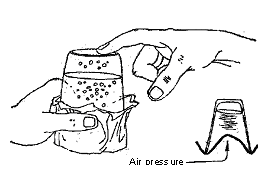
Picture 1
Mr Sidorov: Oh, it’s unbelievable! Thank you!
Mr Kozlov: "Good Morning!” newspaper. Well, I’m interested
in the problem of
ice on the pavements and roads in big cities. Have you solved this
problem?
Chairman: Our laboratory X experts are glad to state that
they invented a very
simple method of solving this problem without using very expensive
equipment. And we can
prove it with this simple experiment. Mrs Pospelova is ready to show you
this experiment.
Mrs Pospelova: We put an ice cube into the glass of water.
We have a piece of
string 10 cm long. First we put the string across the piece of ice, then
we put some salt
on the ice. The ice will melt. Some moments later the water on the ice
cube will freeze.
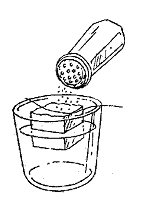
Picture 2
And we can raise the piece of ice! This experiment shows that you
should use much salt
to melt ice near the door of your house. If you don’t put enough salt,
the water will
freeze again.
Mr Kozlov: Thank you for the useful advice.
Mr Johnson: Well, let me ask a question!
Chairman: Yes, please!
Mr Johnson: "Inventions In Science” magazine. There is
some information about
your laboratory X investigations in physics. Could you tell us about
them?
Chairman: Mr Ivanov has the floor.
Mr Ivanov: You are right. Our laboratory work at some
problems in optics. That is
illusion. One of the most interesting of all natural illusions is the
large size of the
full moon when we see it low on the horizon.
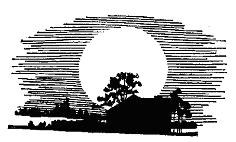
Picture 3
Six hours later when the moon is high in the sky, we think that it
has become much
smaller. But photographs show that the diameter of the moon is the same.
Our version of
this illusion is that the moon on the horizon looks larger because we
can see it together
with some trees or houses (which are on the horizon too). Unfortunately
nowadays we
can’t explain this illusion at sea where there is nothing on the
horizon. This problem
should be solved.
Mr Johnson: Thank you.
Mr Brown: "Daily Telegraph” newspaper. What other problems
in optics do you try
to solve?
Chairman: Mr Petrov has the floor.
Mr Petrov: The next phenomenon we work hard at is a
strange spiral. You can see a
picture.
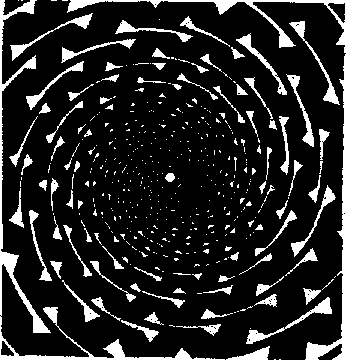
Picture 4
You are sure that the spiral line starts in the centre. But if you
try to follow the
line with a pencil, you’ll find that it is not a spiral. You have a
number of concentric
circles. So our scientists try to solve this problem.
Now we are going to show you a very interesting experiment. We have a
square piece of
cardboard four by four centimeters. There is a picture of a fishbowl on
one side of the
square and a picture of a small fish on the other side. There are two
holes and short
pieces of string (as shown in the picture).
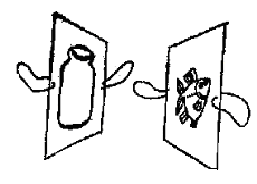
Picture 5
I am holding the pieces of string with the fingers of my hands. Now I
can turn the
square very quickly with my fingers or with any other turning device.
When it is turning
you’ll see only one picture of the fish inside the fishbowl.
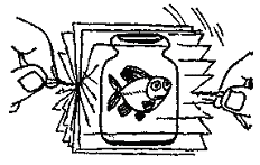
Picture 6
Our experts think this experiment proves that our eyes can keep a
picture of a thing
for half a second after you have put that thing away.
Mr Brown: Thank you.
Mr Hammer: I’ve got a question.
Chairman: Would you like to ask your question?
Mr Hammer: "Today” newspaper. My question deals with a
phenomenon in optics.
Once I put a stamp under the glass of water. And when I put a saucer on
the glass, I
couldn’t see the stamp! How can your scientists explain this phenomenon?
Chairman: I think Mr Alexandrov can do it.
Mr Alexandrov: To my mind the explanation lies in the
phenomenon of refraction. The
rays of light bend when they pass at an angle from water to air. The
lines in Picture show
the refraction. There is no angle from which you can see the stamp. Here
we can show you
the experiment.
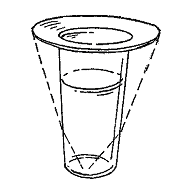
Picture 7
Mr Hammer: Thank you for your explanation.
Mr Zhukov: Let me ask a question!
Chairman: Certainly. You’re welcome.
Mr Zhukov: The "Vedomosti” newspaper, Saint Petersburg.
Some years ago a
television operator turned a large wheel of this sort (shows a picture).
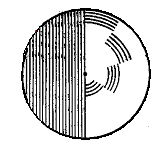
Picture 8
And people who were watching his TV programme saw the colours quite
clearly on their
black-and-white television screens. Do your scientists work at this
problem and can they
give any explanations of this phenomenon? I’ve got a circle of a certain
sort on the
cardboard. Could we watch this phenomenon just now?
Chairman: Of course we can (the phenomenon is shown). And
now I think Mrs
Guralevich can tell us something about this phenomenon.
Mrs Guralevich: Well, I should say that our scientists
were interested in this
phenomenon and they began their work two years ago. The work hasn’t been
finished yet
and we think that the results of our work can be declared in some years.
Mr Zhukov: Thank you very much.
Chairman: I’d like to give you a problem to think and to
have fun. I want to show
you a picture.
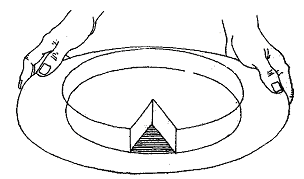
Picture 9
Will you answer the question? Where is the missing piece of cake?
Let’s brainstorm!
Each of you can have a picture. Any ideas?
(People who are present at the conference start brainstorming. If
anybody finds a
solution of this problem this person can be given a prize. Solution: you
should turn the
picture upside down).
Chairman: Well, I think our time is up. Thank you for your
questions and attention.
We hope you are quite satisfied with it. If you have more questions you
can give them in
the written form. Our conference is over.
| 